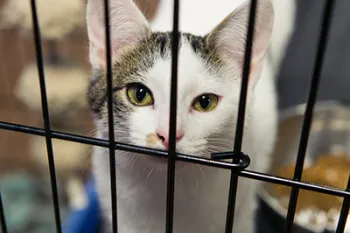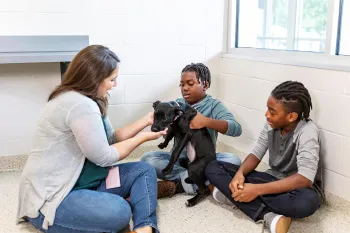Can you provide a temporary home for a cat or dog? Pet fostering is one of the most compassionate and impactful things you can do for animals—and people! Foster volunteers play a critical role in providing a home environment to shelter and rescue pets while they wait for a loving home, and to owned pets whose families may need temporary care for their cat or dog.
What is pet fostering and why does it matter?
Fostering is a temporary commitment to care for a pet. Each pet is different and, if fostering for a local shelter or rescue, they can help match a pet in need with your available time.
Some animals who might need foster care:
- Puppies or kittens (possibly with their mom) too young for adoption
- Animals recovering from surgery or illness
- Dogs or cats who are struggling in a shelter facility
- Pets who need socialization and basic training
- Owned pets whose owners are hospitalized or seeking medical treatment, leaving domestic violence or struggling to find pet-inclusive housing
Fostering offers a home environment in which these animals can decompress, heal from injury or illness, or simply avoid the stress of a shelter environment until they can be reunited with their owner or adopted into a loving family.
Some reasons people choose to foster animals:
- Save space in shelters: Your local shelter may receive more requests to help pets than they have space for; foster homes fill a critical gap for shelters and rescues.
- Reduce stress for pets: Pets thrive in home environments where they receive personal attention; even the most well-resourced shelters can’t always match the comfort of a home.
- Test the waters: Fostering can be a great way to see if pet ownership fits your lifestyle and which pets may be best for your home.
- Help a neighbor: Fostering an owned pet can be a rewarding way to keep pets with their families.
- Teach pet care: Families with children often find fostering helps teach compassion and empathy while providing an opportunity to learn about animal behavior.
How to foster a pet
The benefits of fostering extend far beyond the pet—as a foster caregiver, you not only help an animal until they can move to a permanent home, but you also experience the joy of nurturing an animal in need. Ready to get started? First, explore which type of fostering might be best for you! Then follow our tips for each process.

Mark Stehle/AP Images for The HSUS

kali9/Getty Images
What types of fostering are available?
Person-to-person fostering
Sometimes people in your community may need temporary help with pet care because of a military deployment, treatment for a medical condition, time to seek support for substance misuse, a change to their lease that requires them to find pet-inclusive housing or other urgent situation.
By fostering someone’s pet for them, you provide peace of mind, valuable support and help to keep their family together. If a friend, relative or neighbor is unable to care for their pet, offer to help! Let them know you’re interested in giving their pet a safe and loving temporary home and follow our tips to ensure you’re prepared.
- Sign an agreement. When you agree to foster someone’s pet, put the fostering arrangement in writing. A foster care agreement spells out the arrangement between the pet's owner and the pet's caretaker, including who will cover the cost of food and vet visits. Download a sample temporary pet guardian contract from the Animal Welfare Association.
- Prepare your home. Ask the cat or dog’s family for tips on creating a safe and welcoming environment for your foster pet. To pet-proof your home, move anything that could be dangerous to the pet out of reach, including people food, medications, cleaning products, house plants and electrical wires. If you have other pets, learn about how to safely introduce a new cat or a new dog to your family. Plan to keep the foster pet separate from your resident pets initially.
- Stock up on supplies. Ask about the pet’s favorite foods, toys and bedding. You will likely need pet food and treats, food and water bowls, a cozy bed, grooming supplies and toys, among other things. The pet’s family may provide these, or you may be able to find supplies for free on Nextdoor, Craigslist or through a Buy Nothing group.
- Take photos and videos of your foster pet. If you are fostering for the pet’s family, send them photos and updates of how their cat or dog is doing. You can take great pet photos with your smartphone.
- Care for your foster pet with love and patience. Depending on the pet’s personality, they may feel confused or anxious to be in a different place—at least at first. Give them a quiet room in your apartment or home to decompress and reach out to your local shelter if you have behavior questions.
If you don’t know anyone who needs help caring for their pet, you can sign up with an app like Bestybnb or connect with a local social service agency or animal organization that has a program to help people with temporary care for their pet.
Shelter or rescue fostering
Most shelters and rescue groups are actively seeking foster volunteers, and most can provide all the tools you need to succeed. Many will post fostering opportunities on their websites; check under “Foster” or “Volunteer.” If you can’t find the information online, call or email and tell them you’re interested in fostering.
When fostering for organizations, be aware that each will likely have their own guidelines and requirements. Check their websites for fostering information. Most have a foster program page on their website with an application form or questionnaire. You may also attend an orientation or information session to learn what fostering entails. The application may collect information such as what pets would do best in your home environment, what your schedule is and if you have previous experience with animals or need some guidance. While experience is helpful, it’s not always required! And fostering can be a great way to learn new skills.
Check out these resources for foster caregivers from Maddie’s Fund!
Once you’ve been added to an organization’s foster program, you may receive training on basic care, feeding, medication administration or behavior tips. Organizations will also sometimes provide supplies such as food, crates and litter, as well as veterinary care. Don’t be afraid to ask a shelter or rescue what they’re able to provide and the kinds of animals they need to place in foster care so you can make an informed decision.
You’ll soon be paired with an animal that matches your lifestyle! Some foster parents prefer dogs that need socialization; others enjoy caring for unweaned kittens or senior pets needing quiet homes. You can always discuss your comfort level and availability with the shelter, rescue or individual.
Frequently asked questions about pet fostering
Fostering not only helps people who are overwhelmed or in crisis but also reduces the burden on your local pet shelters. Pets benefit from being in a real home. Some cats and dogs need extra care and support. This includes kittens and puppies who are too young to be adopted, pets with disabilities, pets who are healing from an illness or injury, and senior pets.
Your main responsibilities may include feeding and daily care, administering medications if needed, basic training and exercise, and perhaps most importantly, providing stability and patience. Shelter staff or rescue coordinators will guide you through veterinary appointments or adoption meet-and-greets. You’ll never be alone in the process—support is always available.
Every situation is different. Before you sign a pet guardian contract, talk with the pet’s family or foster organization about their expectations. Let them know how much time you have available, so you can make sure your home is a good fit for the pet. If you can’t commit to weeks or months, ask your local shelter or rescue if you can take a dog home for the weekend. “Sleepover programs” are increasingly common and significantly reduce the stress a dog experiences while waiting for a new home.
It’s normal to form a bond with your foster pet and sometimes this can turn into an adoption! There’s no right or wrong way to foster. Some caregivers find that they don’t want to keep any of their foster animals because it will limit who they can help in the future, while others find a perfect match they can’t let go! If you are interested in potentially adopting a pet you are fostering through an organization, let them know up front. They may have a foster-to-adopt program. If you are fostering for an individual looking for a permanent rehoming for their pet, this is something you will want to discuss ahead of time and include in the fostering agreement. If you’re signing up to foster an owned pet with the hopes of reuniting them with their family, take the time to emotionally prepare yourself for that happy ending!






